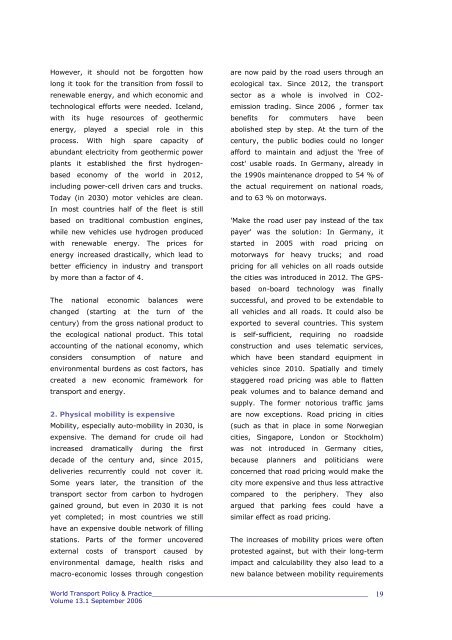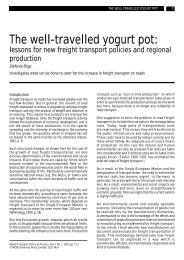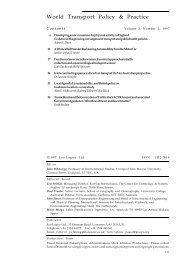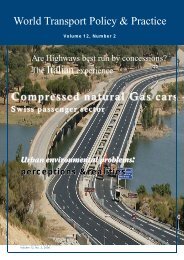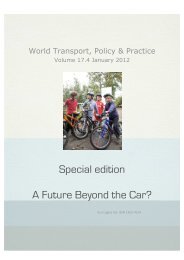Effects of pedestrianisation on the commercial and ... - Eco-Logica
Effects of pedestrianisation on the commercial and ... - Eco-Logica
Effects of pedestrianisation on the commercial and ... - Eco-Logica
Create successful ePaper yourself
Turn your PDF publications into a flip-book with our unique Google optimized e-Paper software.
However, it should not be forgotten how<br />
l<strong>on</strong>g it took for <strong>the</strong> transiti<strong>on</strong> from fossil to<br />
renewable energy, <strong>and</strong> which ec<strong>on</strong>omic <strong>and</strong><br />
technological efforts were needed. Icel<strong>and</strong>,<br />
with its huge resources <str<strong>on</strong>g>of</str<strong>on</strong>g> geo<strong>the</strong>rmic<br />
energy, played a special role in this<br />
process. With high spare capacity <str<strong>on</strong>g>of</str<strong>on</strong>g><br />
abundant electricity from geo<strong>the</strong>rmic power<br />
plants it established <strong>the</strong> first hydrogenbased<br />
ec<strong>on</strong>omy <str<strong>on</strong>g>of</str<strong>on</strong>g> <strong>the</strong> world in 2012,<br />
including power-cell driven cars <strong>and</strong> trucks.<br />
Today (in 2030) motor vehicles are clean.<br />
In most countries half <str<strong>on</strong>g>of</str<strong>on</strong>g> <strong>the</strong> fleet is still<br />
based <strong>on</strong> traditi<strong>on</strong>al combusti<strong>on</strong> engines,<br />
while new vehicles use hydrogen produced<br />
with renewable energy. The prices for<br />
energy increased drastically, which lead to<br />
better efficiency in industry <strong>and</strong> transport<br />
by more than a factor <str<strong>on</strong>g>of</str<strong>on</strong>g> 4.<br />
The nati<strong>on</strong>al ec<strong>on</strong>omic balances were<br />
changed (starting at <strong>the</strong> turn <str<strong>on</strong>g>of</str<strong>on</strong>g> <strong>the</strong><br />
century) from <strong>the</strong> gross nati<strong>on</strong>al product to<br />
<strong>the</strong> ecological nati<strong>on</strong>al product. This total<br />
accounting <str<strong>on</strong>g>of</str<strong>on</strong>g> <strong>the</strong> nati<strong>on</strong>al ec<strong>on</strong>omy, which<br />
c<strong>on</strong>siders c<strong>on</strong>sumpti<strong>on</strong> <str<strong>on</strong>g>of</str<strong>on</strong>g> nature <strong>and</strong><br />
envir<strong>on</strong>mental burdens as cost factors, has<br />
created a new ec<strong>on</strong>omic framework for<br />
transport <strong>and</strong> energy.<br />
2. Physical mobility is expensive<br />
Mobility, especially auto-mobility in 2030, is<br />
expensive. The dem<strong>and</strong> for crude oil had<br />
increased dramatically during <strong>the</strong> first<br />
decade <str<strong>on</strong>g>of</str<strong>on</strong>g> <strong>the</strong> century <strong>and</strong>, since 2015,<br />
deliveries recurrently could not cover it.<br />
Some years later, <strong>the</strong> transiti<strong>on</strong> <str<strong>on</strong>g>of</str<strong>on</strong>g> <strong>the</strong><br />
transport sector from carb<strong>on</strong> to hydrogen<br />
gained ground, but even in 2030 it is not<br />
yet completed; in most countries we still<br />
have an expensive double network <str<strong>on</strong>g>of</str<strong>on</strong>g> filling<br />
stati<strong>on</strong>s. Parts <str<strong>on</strong>g>of</str<strong>on</strong>g> <strong>the</strong> former uncovered<br />
external costs <str<strong>on</strong>g>of</str<strong>on</strong>g> transport caused by<br />
envir<strong>on</strong>mental damage, health risks <strong>and</strong><br />
macro-ec<strong>on</strong>omic losses through c<strong>on</strong>gesti<strong>on</strong><br />
are now paid by <strong>the</strong> road users through an<br />
ecological tax. Since 2012, <strong>the</strong> transport<br />
sector as a whole is involved in CO2emissi<strong>on</strong><br />
trading. Since 2006 , former tax<br />
benefits for commuters have been<br />
abolished step by step. At <strong>the</strong> turn <str<strong>on</strong>g>of</str<strong>on</strong>g> <strong>the</strong><br />
century, <strong>the</strong> public bodies could no l<strong>on</strong>ger<br />
afford to maintain <strong>and</strong> adjust <strong>the</strong> 'free <str<strong>on</strong>g>of</str<strong>on</strong>g><br />
cost' usable roads. In Germany, already in<br />
<strong>the</strong> 1990s maintenance dropped to 54 % <str<strong>on</strong>g>of</str<strong>on</strong>g><br />
<strong>the</strong> actual requirement <strong>on</strong> nati<strong>on</strong>al roads,<br />
<strong>and</strong> to 63 % <strong>on</strong> motorways.<br />
'Make <strong>the</strong> road user pay instead <str<strong>on</strong>g>of</str<strong>on</strong>g> <strong>the</strong> tax<br />
payer' was <strong>the</strong> soluti<strong>on</strong>: In Germany, it<br />
started in 2005 with road pricing <strong>on</strong><br />
motorways for heavy trucks; <strong>and</strong> road<br />
pricing for all vehicles <strong>on</strong> all roads outside<br />
<strong>the</strong> cities was introduced in 2012. The GPSbased<br />
<strong>on</strong>-board technology was finally<br />
successful, <strong>and</strong> proved to be extendable to<br />
all vehicles <strong>and</strong> all roads. It could also be<br />
exported to several countries. This system<br />
is self-sufficient, requiring no roadside<br />
c<strong>on</strong>structi<strong>on</strong> <strong>and</strong> uses telematic services,<br />
which have been st<strong>and</strong>ard equipment in<br />
vehicles since 2010. Spatially <strong>and</strong> timely<br />
staggered road pricing was able to flatten<br />
peak volumes <strong>and</strong> to balance dem<strong>and</strong> <strong>and</strong><br />
supply. The former notorious traffic jams<br />
are now excepti<strong>on</strong>s. Road pricing in cities<br />
(such as that in place in some Norwegian<br />
cities, Singapore, L<strong>on</strong>d<strong>on</strong> or Stockholm)<br />
was not introduced in Germany cities,<br />
because planners <strong>and</strong> politicians were<br />
c<strong>on</strong>cerned that road pricing would make <strong>the</strong><br />
city more expensive <strong>and</strong> thus less attractive<br />
compared to <strong>the</strong> periphery. They also<br />
argued that parking fees could have a<br />
similar effect as road pricing.<br />
The increases <str<strong>on</strong>g>of</str<strong>on</strong>g> mobility prices were <str<strong>on</strong>g>of</str<strong>on</strong>g>ten<br />
protested against, but with <strong>the</strong>ir l<strong>on</strong>g-term<br />
impact <strong>and</strong> calculability <strong>the</strong>y also lead to a<br />
new balance between mobility requirements<br />
World Transport Policy & Practice________________________________________________________<br />
Volume 13.1 September 2006<br />
19


